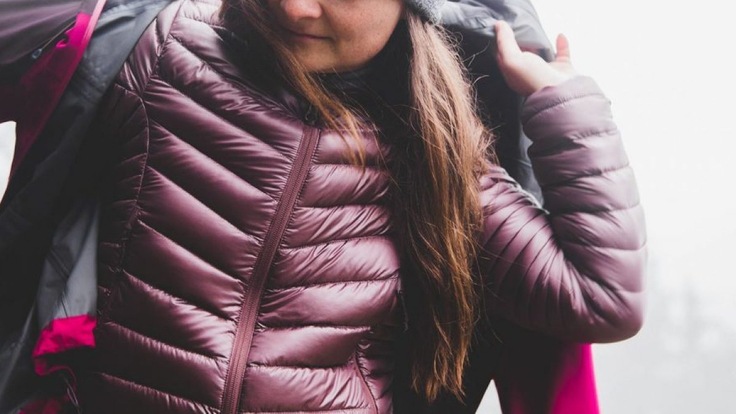On days when your breath hangs in the air, your clothing strategy is key. Here are our tips for how to dress when the temperatures drop.
Layers, Layers Everywhere
Layering lets you adjust your body's thermostat by putting on and removing items to maintain an even comfort level as conditions and your exertion levels change. For a more detailed explanation, read Layering Basics. This clothing strategy is especially important in wintry weather.
To dress for cold weather, you need three layers to work in concert for maximum warmth:
- Base layer: Your long underwear needs to keep your skin as dry as possible.
- Middle layer: Your fleece or puffy jacket needs to hang onto as much body heat as possible.
- Outer layer: Your rain gear needs to protect you from rain and wind.
How to Choose Your Base/Underwear Layer
Warm skin starts with dry skin, so your long undies' job is to wick perspiration away from you. (Wet skin is a recipe for becoming chilled.)
- Fabric: Synthetics like polyesters are great at both wicking and drying. Wool—soft, nonitchy merino wool—is a good natural fiber option.
- Fit: Wicking can't happen in places where fabric isn't touching skin, so you want a comfortably snug (not tight) fit everywhere.
- Thickness (weight): Heavyweight makes sense for below-freezing temps and low activity levels. Midweight is a good all-around choice. Lightweight is best left to milder conditions.
How to Choose Your Middle/Insulating Layer
This is the layer most of us think about in cold conditions, so it's not surprising that its job is to retain warmth.
- Insulation material: If you're a huge fleece fan, then make sure your jacket is heavyweight fleece. When you're talking serious cold, then puffy jackets come into play. Down is the gold standard here, but not so great if it gets wet. Puffy jackets with synthetic fills are your better option when conditions are damp or you'll be breaking a serious sweat. To learn more, read Down vs. Synthetic: Which Insulation is Right for You?
- Insulation thickness: This is tricky because you can't rely on thickness to indicate warmth level when insulation types differ. And any temperature rating on a jacket isn't useful because there are too many variables—wind, rain, activity level and more. You can eyeball two jackets with identical insulation specs, though, and conclude that puffier equals warmer. To learn more, read How to Choose Insulated Outerwear.
- Full coverage: It's easy to become jacket obsessed. Save some love for the legs. Pack along a pair of fleece pants or insulated pants so your lower half can stay as warm as your top side.
How to Choose Your Outer Layer (Shell Jackets and Pants)
This is your outer line of defense. Even though it's often referred to as "rainwear," this layer's job is to shield the underneath layers from snow, sleet, rain and wind. For a detailed discussion on rainwear, read How to Choose Rainwear. Whatever you wear needs three important attributes:
- Precipitation protection: A wicking base layer can't keep your skin dry if what's falling from the skies soaks you from the outside. In winter you don't want to sacrifice any warmth to evaporation cooling. So wear a shell that's "waterproof," rather than merely "water resistant," unless conditions are crystal clear and shelter will always be close at hand. For a deeper dive, read What Does It Mean If a Jacket is Water Resistant?
- Breathable protection: Perspiration wicked by your base layer needs a way to escape. Wear a shell that's breathable or moisture can build up inside it and soak you. You don't need the most expensive GORE-TEX® rainwear—any shell that's designated as "waterproof/breathable" should cover you.
- Windchill protection: The good news is that any shell that's "waterproof" is also "windproof."
- Shell pants: Cold wet ankles are no fun, so be sure your boot tops are covered. If your pants don't do that, then consider adding a pair of gaiters.
How to Keep Your Head, Hands and Feet Warm
To prevent extremities from getting cold, cover up everywhere. You can read How to Keep Your Hands Warm for some tips. The warmest options in hats, gloves and footwear do the same thing as layers elsewhere: wick, insulate and block rain and wind.
- Hats: Wool and synthetic beanies work well, and you can rely on your shell jacket's hood for rain coverage. Full-on winter hats will have insulation inside a shell material. Make sure any headwear covers your ears. If your face is uncomfortably cold, then wear a balaclava.
- Gloves: Fleece gloves provide basic warmth. Insulated gloves, especially ones with waterproof/breathable shells are better. Mittens, because they let finger share warmth, will always be a warmer option than a glove made of the same materials.
- Boots: Boots with thick, non-cotton socks can provide warmth when conditions are merely cold but not wet or snowy. Waterproof boots are the next step up. Winter boots, in addition to offering traction on snow or ice, will include insulation.
- A warmer coat: Think of this as a twist on "cold hands, warm heart." If your heart is truly toasty, then it has plenty of warm blood to pump out to your hands and feet.
- Warming packets: You can also add warmth by slipping hand or foot warmers inside your gloves or socks. Some gloves include pockets sized for the packets. Brands like Grabber and Heat Factory make them in a variety of sizes.
- Electric accessories: If you prefer nondisposable heat (and have lots of disposable income) you can get rechargeable warmers, gloves, socks and insoles. The price for these is steep, though, so most people only turn to them if their hands and feet are chronically cold.
Additional Layering Tips for Cold Weather
- Don't wait to adjust layers: Throw on a shell at the first sign of rain or wind, and remove your insulating jacket the minute you start to sweat. Staying warm and dry is easier than warming up or drying out.
- Cotton is a no-no in any layer: Set aside your love of cotton flannel (or anything cotton) because it soaks up water and takes forever to dry out. That's a recipe for hypothermia.
- Layers should play well together: Middle and outer layers need to glide on and off. When they fit too tightly with the layers beneath them, then adjustments become cumbersome and you risk constricting circulation.
Beyond Clothing
To learn additional strategies for staying warm outdoors, and about cold-weather health concerns, read How Do I Stay Warm Without a Fire and Winter Camping and Backpacking Tips.

